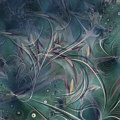|


© Janet Parke |
United States Culture... A BRIEF History |
The United Sates has evolved over the years in response to the world's changing ideas about children and childhood.
In the Beginning
Prior to the 1600's, children were not given their own literature. Most stories were carried by spoken word by minstrels and bards who strolled from town to town, and regional differences in common tales can be seen today. Change Begins
early settlers to the New World were mostly single men. However, there were family groups, especially those of the Puritans. The Puritans viewed children, as was common in the 1600's and 1700's, as small adults. Due to high infant mortality rates and a short lifespan, children were not even often named until after their first year. Furthermore, the Puritans felt that an individual was born in sin and only through an salvation during one's lifetime could one be afforded a possibility of getting into heaven. Therefore, any material for children was didactic... direct instruction as to the ways that one would avoid sand and ultimately attain salvation. There was no entertainment for children per se beyond that found in biblical scripture. Essentially, the Puritans felt that in order to change or affect behavior, one had to be pushed or pulled into it, and the material written for children was rather dry and harsh.
Other groups that came to what was to become the United States were largely uneducated, including slaves and indentured servants, and later, refugees from Western Europe, Eastern Europe and eventually Asian and South America. Many of the adults in a family could not read, let alone their children. Therefore, any literature for children was usually passed on orally and therefore would reflect the region and the specific culture from which the material originated.
This began to change in the late 1600s when John Locke proposed the notion that a softer approach might be more effective in getting children to change their behavior... to lead them rather than to pull or push them. He was quite fond of material such as Aesop's fables, which presented life lessons, but used familiar animal figures symbolically in the material in order to present the reader with life lessons rather than dire predictions of hellfire or promises of eternal life in heaven. IMMIGRANT SONG
Children's literature in America was also profoundly affected by a literature from Europe. When France's Perrault stories were translated into English, the stories were brought over by New World settlers. Furthermore, the influence of other countries' immigrants, including those from Ireland, Spain and Portugal, Italy and Norway was mixed in with indigenous tales, as well as his storable stories based on the founding of the New World. This cornucopia of narratives and fables created its own genre, including the tall tale, with characters such as Paul Bunyan, Pecos Bill and Johnny Appleseed. Specifically, this type of literature reflected the Frontier aspect of the New World, as well as the grandiose nature of what was to become the United States. Specifically, the Paul Bunyan tales, as well as those of Pecos Bill, reflected not only a specific American Western theme, but also the larger-than-life existence of the character who is either large in stature or large in fame. Johnny Appleseed's tale is specifically American, with the notion of spreading the influence across a vast untamed land. These styories were designed for general pubic consumption, but were especially loved by children.
By the 1940s and fifties, much of what passed for children's literature had been codified into a series of primers that are specifically designed to teach children to read. Most notably of these worthy "Dick and Jane" series in which essentially nondescript children were depicted doing mundane things and repetitive short sentences designed to teach children fundamental English. Also, there worthy instructional works like the Goops essentially to a culture rate them to the values and social norms of society. This was challenged in the 1950s and forward by animators such as Dr. Seuss, who reflected a more accurate portrayal of children as inventive, imaginative and even disobedient. While it is undeniable that Dr. Seuss's material was indeed constructive and enlightening, his fanciful stories, filled with fantastic characters and made-up words not only engage the reader, but also reflected the realities of the childhood's life, including the negative aspects of fear and battles with esteem. AND NOW.....
Today children's literature in America is a diverse collection of everything from the strictly religious to teh trans-cultural to the all inclusive: from Bible tracts to stories of new cultures (Hello, Amigos)to tales that challenge cultural mainstream values (My Working Mom, Mom and Mum are Getting Married)
Works Cited
Saltman, Judith. Trade and Plumbcake Forever. The Riverside Anthology of Children's Literature, 6th ed.
Houghton Mifflin, 1985.
© T. T. Eiland, August, 2006
Last modified: August 5, 2006
|
